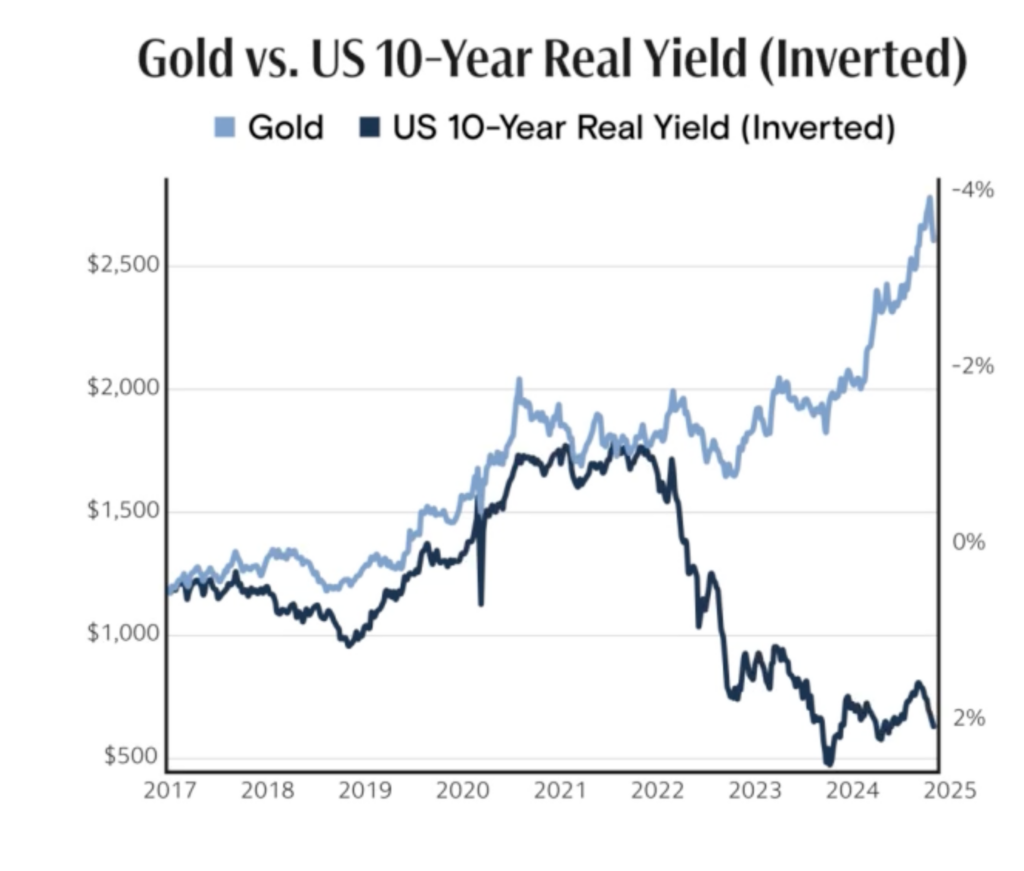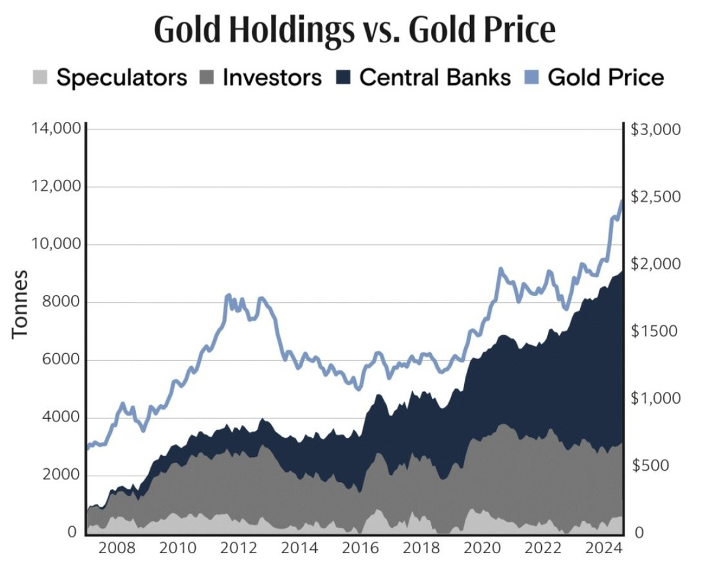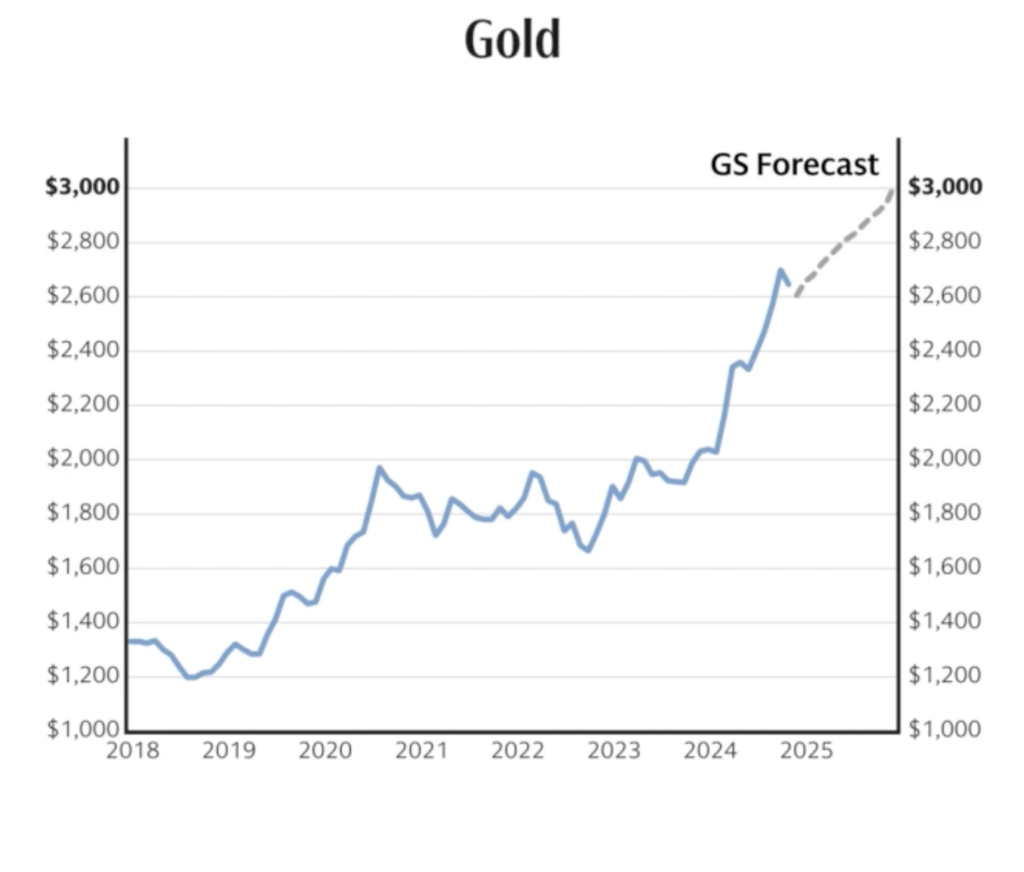Gold’s years-long rally has defied conventional trends and bullish expectations as the yellow metal closes in on more than 40% gains since 2022. Driven by record-breaking central bank demand, gold has broken free from its typical inverse relationship with interest rates, creating a unique price dynamic not seen in years. Recently, Goldman Sachs Research unpacked the reasons behind this extraordinary rally and why it’s likely to continue well into 2025.
Gold’s Split From Interest Rates
Impressive gains and several record highs aren’t the only unique characteristics of this gold spike. The yellow metal’s performance over the past few years is also “strange” due to its uncharacteristic behavior compared to the broader market. Traditionally, gold prices and interest rates have maintained a negative correlation—when one rises, the other tends to fall.
Gold demand and prices often falter when real interest rates (adjusted for inflation) increase. Alternatively, falling interest rates make gold more appealing, leading to more investments and positive price action. “Typically, higher interest rates make gold less attractive because gold doesn’t pay an interest,” explains Lina Thomas, Goldman Sachs Research commodities strategist.
From 2017 to 2022, gold prices closely mirrored the movements of the US 10-year real yield bonds–a benchmark for real interest rates. (Note: The “inverted” graph flips real interest rates, making it easier to see how they usually move opposite to gold prices.)

Since 2022, the conventional relationship between gold prices and bond yields has flipped. This trend’s stark reversal was triggered by the Russian invasion of Ukraine. In response, the international community froze the reserves of the Central Bank of the Russian Federation and imposed heavy sanctions. Rather than deterring Russia, this move had the unintended consequence of pushing the country to stockpile gold to circumvent the dollar’s weaponization.
A New Era of Gold Demand
The overnight seizing of Russian assets served as a “wake-up call” for governments around the world, even among US allies. This move launched a new era of gold demand and sparked the “great gold rally.” Central banks charted record-high gold consumption in 2022, 2023, and the first half and Q3 of 2024. As the largest and most active investors, central bank demand remains one of the most decisive factors influencing gold prices. Thus, prices saw dramatic increases in line with booming demand.

As a de-facto leader of the BRICS nations, Russia’s shift into gold encouraged several other emerging economies to follow suit. In 2024 alone, Russia upped its daily gold purchases by 700%, pushing its gold reserves to a 25-year high. China, a major regional and economic ally, instituted gold-buying quotas to sustain its precious metals consumption and might have discovered the world’s largest gold deposit.
“We don’t see central bank demand slowing down,” reports Thomas.
Although retail investor and speculative demand have fallen behind central bank buying over the past few years, signs point to an uptick in demand as investors follow in the footsteps of national-level investors. Goldman Sachs Research highlights the Federal Reserve’s rate cuts as green-lighting more investments from retail players. This uptick in demand is expected to further bolster gold prices.
Elevated Forecasts & Greater Momentum
Despite a 30% yearly gain, 2025 gold price predictions remain firmly optimistic. In fact, experts have had to raise their forecasts several times given the yellow metal’s formidable momentum. The metal’s strong rebound from a post-election slump underscores the strength of the forces behind its rise. Experts cite deep-rooted economic issues like national debt, inflation, excessive spending, and escalating geopolitical tensions as primary factors driving both current and anticipated gold growth.

Given these factors, Goldman Sachs predicts gold will reach $3,000 by 2025, representing a gain of over 13%. The banking giant has even actively encouraged investors to “go for gold”, suggesting that current prices are decent entry points given the metal’s potential upward trajectory.





